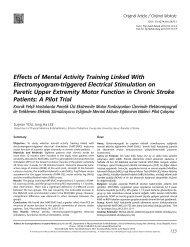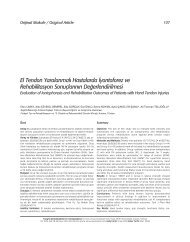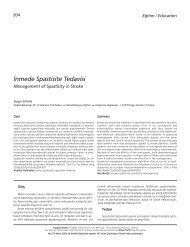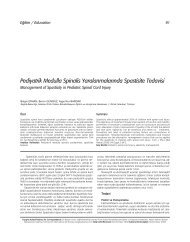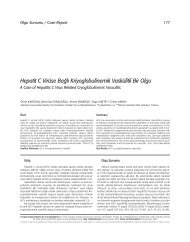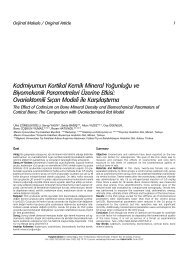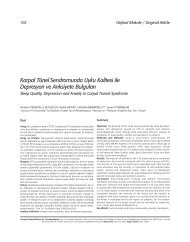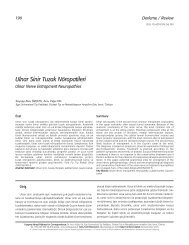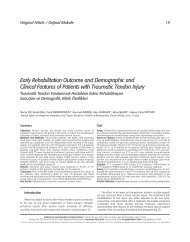Transcranial Doppler Ultrasound in the Rehabilitation ... - FTR Dergisi
Transcranial Doppler Ultrasound in the Rehabilitation ... - FTR Dergisi
Transcranial Doppler Ultrasound in the Rehabilitation ... - FTR Dergisi
Create successful ePaper yourself
Turn your PDF publications into a flip-book with our unique Google optimized e-Paper software.
42<br />
<strong>Transcranial</strong> <strong>Doppler</strong> <strong>Ultrasound</strong> <strong>in</strong> <strong>the</strong><br />
<strong>Rehabilitation</strong> of Post-Stroke Patients<br />
Summary<br />
<strong>Transcranial</strong> <strong>Doppler</strong> <strong>Ultrasound</strong> (TCD) is a non<strong>in</strong>vasive, <strong>in</strong>expensive and<br />
portable imag<strong>in</strong>g modality, which obta<strong>in</strong>s <strong>in</strong>formation about <strong>the</strong> blood flow<br />
velocity <strong>in</strong> large <strong>in</strong>tracranial arteries. TCD has several advantages <strong>in</strong> <strong>the</strong> <strong>in</strong>vestigation<br />
and treatment of acute ischemic stroke, but is <strong>in</strong>appropriately<br />
used <strong>in</strong> rehabilitation.<br />
Normal blood flow velocity <strong>in</strong> <strong>the</strong> middle cerebral artery (MCA) of <strong>the</strong> damaged<br />
hemisphere after stroke is associated with better rehabilitation outcome.<br />
Improved blood supply to <strong>the</strong> damaged hemisphere is associated with<br />
a favorable outcome, oppositely to <strong>the</strong> undamaged hemisphere.<br />
The decreased blood flow velocity <strong>in</strong> <strong>the</strong> damaged MCA is associated with<br />
orthostatic hypotension symptoms after stroke. Those patients are <strong>in</strong> high<br />
risk for develop<strong>in</strong>g syncopal reactions and should be elevated from sup<strong>in</strong>e<br />
position and treated on tilt table with caution, especially at <strong>the</strong> beg<strong>in</strong>n<strong>in</strong>g of<br />
<strong>the</strong> rehabilitation.<br />
The performance of speech tasks is associated <strong>in</strong> aphasia stroke patients<br />
with much lower left hemisphere activation <strong>in</strong> comparison with <strong>the</strong> healthy<br />
subjects. High blood flow velocity <strong>in</strong> <strong>the</strong> right MCA was found to be a good<br />
prognostic sign for language ability. Arterial blood flow shift towards <strong>the</strong> left<br />
hemisphere dur<strong>in</strong>g speech tasks is associated with poor language ability.<br />
The TCD technology can be an important additional tool for monitor<strong>in</strong>g rehabilitation<br />
process, predict<strong>in</strong>g functional outcome, evaluat<strong>in</strong>g bra<strong>in</strong> reorganization<br />
strategies and develop<strong>in</strong>g new <strong>the</strong>rapeutic modalities <strong>in</strong> post-stroke<br />
rehabilitation. Turk J Phys Med Rehab 2005;51(2):42-44<br />
Key Words: <strong>Transcranial</strong> doppler ultrasound, ischemic stroke, rehabilitation,<br />
functional outcome<br />
<strong>Doppler</strong> is a non<strong>in</strong>vasive, <strong>in</strong>expensive and portable imag<strong>in</strong>g modality<br />
that uses sound waves directed toward a target blood vessel<br />
and <strong>the</strong> measurement of <strong>the</strong> <strong>Doppler</strong> shift of <strong>the</strong> reflected wave.<br />
From this, flow velocity is calculated. Aaslid et al. (1) demonstrated<br />
rout<strong>in</strong>e <strong>Transcranial</strong> <strong>Doppler</strong> ultrasound (TCD) exam<strong>in</strong>ation of <strong>the</strong><br />
Özet<br />
Review / Derleme<br />
‹nme Sonras› Hastalar›n Rehabilitasyonunda Transkraniyal <strong>Doppler</strong> Ultrasonografi<br />
Iuly TREGER, Haim RING<br />
Loevenste<strong>in</strong> <strong>Rehabilitation</strong> Hospital, Ra’anana, Israel<br />
Sackler Faculty of Medic<strong>in</strong>e, Tel Aviv University, Tel Aviv, Israel<br />
Transkraniyal <strong>Doppler</strong> Ultrason (TKD) <strong>in</strong>vaziv olmayan, ucuz ve tafl›nabilir<br />
bir görüntüleme modalitesi olup genifl çapl› <strong>in</strong>trakranial arterler<strong>in</strong> kan<br />
ak›m h›z›n› gösterir. TKD’n<strong>in</strong> iskemik <strong>in</strong>meler<strong>in</strong> araflt›r›lma ve tedaviler<strong>in</strong>de<br />
birçok avantaj› vard›r, ancak rehabilitasyonda kullan›m› yetersizdir.<br />
‹nme sonras› hasarl› hemisferde orta serebral arter (OSA) kan ak›m h›z›n›n<br />
normal olmas› rehabilitasyon sonuçlar›n› olumlu etkilemektedir. Hasars›z<br />
hemisfer<strong>in</strong> aks<strong>in</strong>e hasarl› hemisferde kan ak›m›n›n art›r›lmas› olumlu sonuçlara<br />
yol açar.<br />
‹nme sonras› hasarl› OSA’da kan ak›m h›z›n›n azalmas› ortostatik hipotansiyon<br />
semptomlar› ile sonuçlan›r. Bu hastalar senkop reaksiyonlar› aç›s›ndan<br />
yüksek risk alt›ndad›rlar ve özellikle rehabilitasyon program›n›n bafllar›nda<br />
sup<strong>in</strong> pozisyonundan kald›r›l›p tilt masas›nda tedavi edilirlerken dikkatli<br />
olunmal›d›r.<br />
Normal sa¤l›kl› bireylerle mukayese edildi¤<strong>in</strong>de afazik <strong>in</strong>meli hastalarda<br />
konuflma görevler<strong>in</strong><strong>in</strong> yap›lmas› daha az sol hemisfer aktivasyonu ile birliktedir.<br />
Sa¤ OSA’da yüksek kan ak›m h›z›n›n, dil yetene¤i aç›s›ndan iyi bir<br />
prognostik faktör oldu¤u bulunmufltur. Konuflma görevleri esnas›nda arteriel<br />
kan ak›m›n›n sol hemisfere kaymas› dil yetene¤<strong>in</strong><strong>in</strong> yetersizli¤i ile birliktedir.<br />
TKD teknolojisi, <strong>in</strong>me sonras› rehabilitasyon program›n›n monitorizasyonu,<br />
fonksiyonel prognozun belirlenmesi, beyn<strong>in</strong> reorganizasyon stratejiler<strong>in</strong><strong>in</strong><br />
de¤erlendirilmesi ve yeni terapötik modaliteler<strong>in</strong> gelifltirilmes<strong>in</strong>de önemli<br />
bir ilave yöntem olabilir. Türk Fiz T›p Rehab Derg 2005;51(2):42-44<br />
Anahtar Kelimeler: Transkraniyal doppler ultrasonografi, iskemik <strong>in</strong>me, rehabilitasyon,<br />
fonksiyonel sondurum<br />
<strong>in</strong>tracranial arteries to be possible <strong>in</strong> 1982. TCD can show potency<br />
of any large <strong>in</strong>tracranial artery throw one of "w<strong>in</strong>dows" upon <strong>the</strong><br />
skull. TCD is <strong>the</strong> ideal rapid, real-time bedside tool for evaluation of<br />
cerebral vessels (2,3). It has several advantages <strong>in</strong> <strong>the</strong> rapid <strong>in</strong>vestigation<br />
and treatment of acute ischemic stroke particularly <strong>in</strong> <strong>the</strong><br />
Yaz›flma Adresi: Dr. Haim R<strong>in</strong>g-Neurological <strong>Rehabilitation</strong> Department Loewenste<strong>in</strong>, <strong>Rehabilitation</strong> Center, P.O. Box 3, 43100, Ra'anana, Israel<br />
Tel: 972 9 7709183 Faks: 972 9 7709937 e-posta: hr<strong>in</strong>g@post.tau.ac.il Kabul Tarihi: Nisan 2005
Türk Fiz T›p Rehab Derg 2005;51(2):42-44<br />
Turk J Phys Med Rehab 2005;51(2):42-44<br />
sett<strong>in</strong>g of thrombolysis (4,5). TCD is especially useful <strong>in</strong> <strong>the</strong> Middle<br />
Cerebral Artery (MCA) blood flow velocity measurements, where it<br />
reaches close to 100% specificity values (6,7).<br />
It was shown before, that most significant changes <strong>in</strong> flow velocities<br />
accord<strong>in</strong>g to TCD measurements take place <strong>in</strong> <strong>the</strong> first hours<br />
after stroke (8), but <strong>in</strong>tracranial circulation can also be dynamic<br />
after weeks and months (9,10).<br />
Several studies have shown that TCD f<strong>in</strong>d<strong>in</strong>gs can predict cl<strong>in</strong>ical<br />
outcome (11,12). Patients with acutely normal TCD have a favorable<br />
prognosis (13) and documented <strong>in</strong>tracranial occlusion or a hemispheric<br />
asymmetry pattern is associated with a poor outcome<br />
(14). The persistence of occlusion appears particularly important.<br />
In our recent study (15) we explored <strong>the</strong> association between<br />
Mean Flow Velocity (MFV) <strong>in</strong> <strong>the</strong> MCA of both hemispheres and<br />
<strong>the</strong> severity of functional disability and neurological impairment<br />
dur<strong>in</strong>g <strong>in</strong>-hospital acute rehabilitation treatment of patients after<br />
a first-ever ischemic stroke <strong>in</strong> <strong>the</strong> MCA territory. Our f<strong>in</strong>d<strong>in</strong>gs suggest<br />
that TCD measurements on admission to <strong>the</strong> rehabilitation<br />
department are associated with Functional Independence Measure<br />
(FIM) and National Institutes of Health Stroke Scale (NIHSS)<br />
scores at <strong>the</strong> beg<strong>in</strong>n<strong>in</strong>g and dur<strong>in</strong>g <strong>the</strong> rehabilitation of ischemic<br />
stroke patients. As <strong>in</strong> <strong>the</strong> acute stage, absent or low MFV <strong>in</strong> <strong>the</strong><br />
MCA of damaged hemisphere is correlated with a far worse functional<br />
and neurological outcome, especially after one and two<br />
months of <strong>in</strong>patient rehabilitation. We found that higher MFV <strong>in</strong><br />
MCA of damaged hemisphere is correlated with better functional<br />
and neurological parameters dur<strong>in</strong>g two months of rehabilitation.<br />
This suggests that better blood supply to damaged hemisphere at<br />
<strong>the</strong> beg<strong>in</strong>n<strong>in</strong>g of <strong>the</strong> rehabilitation period is associated with a favorable<br />
outcome. MFV <strong>in</strong> <strong>the</strong> MCA of undamaged hemisphere one<br />
month after admission was found to be <strong>in</strong> negative correlation<br />
with FIM values on admission, one and two months later. This suggests<br />
that better blood supply to <strong>the</strong> undamaged hemisphere dur<strong>in</strong>g<br />
rehabilitation is associated with a poorer functional outcome.<br />
Accord<strong>in</strong>g to our study <strong>the</strong> repetitive TCD exam<strong>in</strong>ations are useful<br />
<strong>in</strong> predict<strong>in</strong>g outcome <strong>in</strong> acute stroke patients.<br />
TCD was found to be especially helpful <strong>in</strong> monitor<strong>in</strong>g of blood<br />
velocities <strong>in</strong> large <strong>in</strong>tracerebral arteries dur<strong>in</strong>g postural changes<br />
(16). Orthostatic hypotension (OH) is a prevalent condition, which<br />
can lead to peripheral blood pressure drop <strong>in</strong> association with<br />
presyncopal symptoms or even vasovagal syncope, which is associated<br />
with ischemic stroke and can affect <strong>the</strong> rehabilitation outcome<br />
(17,18). Assumption of <strong>the</strong> upright position is associated with a<br />
reduction <strong>in</strong> venous return and cardiac output, and blood pressure<br />
is ma<strong>in</strong>ta<strong>in</strong>ed with a sympa<strong>the</strong>tically mediated <strong>in</strong>crease <strong>in</strong> vascular<br />
resistance (19). Cerebral autoregulation refers to <strong>the</strong> <strong>in</strong>herent ability<br />
of cerebral blood vessels to keep cerebral blood flow constant<br />
over a wide range of systemic blood pressure (20). This ability is<br />
disturbed <strong>in</strong> stroke patients and can lead to a fall <strong>in</strong> cerebral blood<br />
flow velocity dur<strong>in</strong>g orthostatic stress with head-up tilt (21).<br />
Our recent study <strong>in</strong>vestigated <strong>the</strong> correlation between OH and<br />
MFV <strong>in</strong> <strong>the</strong> MCA bilaterally dur<strong>in</strong>g Tilt Table Test (TTT) <strong>in</strong> acute ischemic<br />
stroke patients undergo<strong>in</strong>g rehabilitation (Treger I, Shafir<br />
O, Keren O, R<strong>in</strong>g H, unpublished data, 2005). Our f<strong>in</strong>d<strong>in</strong>gs suggest<br />
that <strong>the</strong> appearance of OH symptoms is associated with decreased<br />
blood flow velocity <strong>in</strong> damaged MCA at <strong>the</strong> beg<strong>in</strong>n<strong>in</strong>g of rehabilitation<br />
treatment after ischemic stroke. Among post-stroke<br />
patients <strong>the</strong> decrease <strong>in</strong> peripheral blood pressure dur<strong>in</strong>g TTT is<br />
correlated with a drop <strong>in</strong> MFV <strong>in</strong> healthy MCA, but not <strong>in</strong> <strong>the</strong> artery<br />
<strong>in</strong> <strong>the</strong> damaged hemisphere. Patients with low MFV <strong>in</strong> <strong>the</strong><br />
MCA of <strong>the</strong> damaged hemisphere, as measured by TCD, are <strong>in</strong> high<br />
risk for develop<strong>in</strong>g syncopal reactions and <strong>the</strong>refore should be<br />
identified on admission.<br />
Treger ve R<strong>in</strong>g<br />
<strong>Transcranial</strong> <strong>Doppler</strong> <strong>in</strong> Stroke <strong>Rehabilitation</strong><br />
43<br />
Changes <strong>in</strong> flow velocity <strong>in</strong> <strong>the</strong> large cerebral arteries are<br />
strictly related to changes <strong>in</strong> <strong>the</strong> diameter of small resistance vessels<br />
whose dilatation reflects an <strong>in</strong>crease of regional metabolic activity<br />
and whose constriction reflects a decrease. Even if changes<br />
<strong>in</strong> blood flow velocities cannot be used for describ<strong>in</strong>g absolute values<br />
of cerebral blood flow, changes <strong>in</strong> flow velocity can be considered<br />
reliable <strong>in</strong>dicators of flow changes and <strong>the</strong>n of modification<br />
of bra<strong>in</strong> perfusion <strong>in</strong> <strong>the</strong> territory supplied by <strong>the</strong> large <strong>in</strong>tracerebral<br />
arteries (22). The possibility of <strong>in</strong>vestigat<strong>in</strong>g changes <strong>in</strong> cerebral<br />
activity dur<strong>in</strong>g mental and motor activity with TCD has been<br />
widely validated <strong>in</strong> previous studies (23,24).<br />
Studies of cerebral metabolism and blood flow have provided<br />
very <strong>in</strong>terest<strong>in</strong>g data about <strong>the</strong> importance of residual functionality<br />
of structures <strong>in</strong> <strong>the</strong> dom<strong>in</strong>ant hemisphere and of early activation<br />
of areas <strong>in</strong> <strong>the</strong> unaffected hemisphere <strong>in</strong> <strong>the</strong> recovery from<br />
aphasia and o<strong>the</strong>r neurological deficits (25). With TCD it is possible<br />
to obta<strong>in</strong> <strong>in</strong>formation about changes <strong>in</strong> cerebral activity <strong>in</strong> both<br />
normal and pathologic conditions (26).<br />
High temporal resolution of TCD allows a cont<strong>in</strong>uous and bilateral<br />
monitor<strong>in</strong>g of blood flow of <strong>the</strong> basal cerebral arteries. Functional<br />
TCD research exam<strong>in</strong>es velocity changes dur<strong>in</strong>g <strong>the</strong> performance<br />
of mental tasks (27). These <strong>in</strong>vestigations are highly important<br />
for understand<strong>in</strong>g of <strong>the</strong> normal bra<strong>in</strong> function<strong>in</strong>g and <strong>the</strong><br />
mechanisms of recovery after <strong>in</strong>jury.<br />
Our recent study <strong>in</strong>vestigated <strong>the</strong> correlation between <strong>the</strong><br />
MFV <strong>in</strong> <strong>the</strong> MCA bilaterally dur<strong>in</strong>g speech tasks <strong>in</strong> acute ischemic<br />
stroke patients undergo<strong>in</strong>g rehabilitation (Treger I, Luzki L, Gil M,<br />
R<strong>in</strong>g H, unpublished data, 2005). Our f<strong>in</strong>d<strong>in</strong>gs suggest that <strong>the</strong> active<br />
function<strong>in</strong>g of <strong>the</strong> right hemisphere is extremely important <strong>in</strong><br />
<strong>the</strong> improvement of language ability <strong>in</strong> post-stroke patients with<br />
aphasia dur<strong>in</strong>g early stages of <strong>in</strong>patient rehabilitation. The performance<br />
of speech tasks is associated <strong>in</strong> aphasia stroke patients<br />
with much lower left hemisphere activation <strong>in</strong> comparison with<br />
<strong>the</strong> healthy subjects, as detected by TCD monitor<strong>in</strong>g. In our study,<br />
high blood flow velocity <strong>in</strong> <strong>the</strong> right MCA of aphasia patients was<br />
found to be a good prognostic sign for better language ability after<br />
one month of rehabilitation treatment. By comparison, a high<br />
MFV <strong>in</strong> <strong>the</strong> left hemisphere MCA was associated with worse speech<br />
recovery dur<strong>in</strong>g <strong>the</strong> first month of hospitalization. A shift <strong>in</strong><br />
arterial blood flow toward <strong>the</strong> left hemisphere dur<strong>in</strong>g speech<br />
tasks was associated <strong>in</strong> our study with pure language ability one<br />
month after stroke. Our study shows <strong>the</strong> <strong>in</strong>creased role of <strong>the</strong><br />
right hemisphere <strong>in</strong> lexical-semantic process<strong>in</strong>g by aphasia patients<br />
dur<strong>in</strong>g early recovery <strong>in</strong> sub-acute <strong>in</strong>-patient rehabilitation. It<br />
can be important <strong>in</strong> develop<strong>in</strong>g new, effective techniques of poststroke<br />
language rehabilitation.<br />
The American Academy of Neurology technology assessment<br />
report (28) stated that TCD has established value <strong>in</strong> <strong>the</strong> assessment<br />
of patients with <strong>in</strong>tracranial stenosis, collaterals, subarachnoid<br />
hemorrhage, and bra<strong>in</strong> death. It is widely used <strong>in</strong> stroke units,<br />
neurology, neurosurgery, cardiology, vascular surgery, and o<strong>the</strong>r<br />
departments of acute patients’ care.<br />
So far, TCD technology is not appropriately used <strong>in</strong> <strong>the</strong> neurological<br />
rehabilitation departments and only some <strong>in</strong>vestigations<br />
were done to evaluate <strong>the</strong> significance of later changes <strong>in</strong> <strong>the</strong> bra<strong>in</strong><br />
hemodynamics after bra<strong>in</strong> <strong>in</strong>jury.<br />
Early prediction of improvement is essential for plann<strong>in</strong>g <strong>the</strong><br />
re<strong>in</strong>tegration of patients <strong>in</strong>to social life and <strong>the</strong>ir need for care<br />
and, more specifically, for select<strong>in</strong>g subjects who might benefit<br />
most from rehabilitation. The results of bra<strong>in</strong> reorganization studies<br />
by <strong>the</strong> functional TCD can help a lot <strong>in</strong> develop<strong>in</strong>g new effective<br />
techniques <strong>in</strong> stroke patients’ rehabilitation.
44<br />
Treger ve R<strong>in</strong>g<br />
<strong>Transcranial</strong> <strong>Doppler</strong> <strong>in</strong> Stroke <strong>Rehabilitation</strong><br />
References<br />
1. Aaslid R, Markwalder TM, Nornes H. Non<strong>in</strong>vasive transcranial <strong>Doppler</strong><br />
ultrasound record<strong>in</strong>g of flow velocity <strong>in</strong> basal cerebral arteries. J Neurosurg<br />
1982;57:769–74.<br />
2. Babikian VL, Feldmann E, Wechsler LR, Newell DW, Gomez CR, Bogdahn<br />
U, et al. <strong>Transcranial</strong> <strong>Doppler</strong> ultrasonography: year 2000 update.<br />
J Neuroimag<strong>in</strong>g 2000;10:101–5.<br />
3. Demchuk AM, Christou I, We<strong>in</strong> TH, Felberg RA, Malkoff M, Grotta JC,<br />
et al. Specific transcranial <strong>Doppler</strong> flow f<strong>in</strong>d<strong>in</strong>gs related to <strong>the</strong> presence<br />
and site of arterial occlusion. Stroke 2000;31:140–6.<br />
4. Soustiel JF, Shik V, Shreiber R, Tavor Y, Goldsher D. Basilar vasospasm<br />
diagnosis. Stroke 2002;33(1):72-8.<br />
5. Alexandrov AV, Felberg RA, Demchuk AM, Christou I, Burg<strong>in</strong> WS, Malkoff<br />
M, et al. Deterioration follow<strong>in</strong>g spontaneous improvement: Sonographic<br />
f<strong>in</strong>d<strong>in</strong>gs <strong>in</strong> patients with acutely resolv<strong>in</strong>g symptoms of cerebral<br />
ischemia. Stroke 2000;31:915-9.<br />
6. Camerl<strong>in</strong>go M, Casto L, Censori B, Ferraro B, Gazzaniga GC, Mamoli A.<br />
<strong>Transcranial</strong> <strong>Doppler</strong> <strong>in</strong> acute ischemic stroke of <strong>the</strong> middle cerebral<br />
artery territories. Acta Neurol Scand 1993;88:108–11.<br />
7. Wijman CAC, McBee NA, Keyl PM, Varelas PN, Williams MA, Ulatowski<br />
JA, et al. Diagnostic impact of early transcranial <strong>Doppler</strong> ultrasonography<br />
on <strong>the</strong> TOAST classification subtype <strong>in</strong> acute cerebral ischemia.<br />
Cerebrovasc Dis 2001;11:317-23.<br />
8. Fieschi C, Argent<strong>in</strong>o C, Lenzi GL, Sacchetti ML, Toni D, Bozzao L. Cl<strong>in</strong>ical<br />
and <strong>in</strong>strumental evaluation of patients with ischemic stroke<br />
with<strong>in</strong> <strong>the</strong> first six hours. J Neurol Sci 1989;91:311–21.<br />
9. Akopov S, Whitman GT. Hemodynamic studies <strong>in</strong> early ischemic stroke:<br />
serial transcranial <strong>Doppler</strong> and magnetic resonance angiography<br />
evaluation. Stroke 2002;33(5):1274-9.<br />
10. Wong KS, Li H, Lam WWM, Chan YL, Kay R. Progression of middle cerebral<br />
artery occlusive disease and its relationship with fur<strong>the</strong>r vascular<br />
events after stroke. Stroke 2002;33:532-6.<br />
11. Camerl<strong>in</strong>go M, Casto L, Censori B, Servalli MC, Ferraro B, Mamoli A.<br />
Prognostic use of ultrasonography <strong>in</strong> acute non-hemorrhagic carotid<br />
stroke. Ital J Neurol Sci 1996;17(3):215-8.<br />
12. Kaps M, Teschendorf U, Dorndorf W. Hemodynamic studies <strong>in</strong> early<br />
stroke. J Neurol 1992;239:138–42.<br />
13. Alexandrov AV, Blad<strong>in</strong> CF, Norris JW. Intracranial blood flow velocities<br />
<strong>in</strong> acute ischemic stroke. Stroke 1994;25:1378–83.<br />
14. Arenillas JF, Mol<strong>in</strong>a CA, Montaner J, Abilleira S, González-Sánchez<br />
MA, Álvarez-Sabín J. Progression and cl<strong>in</strong>ical recurrence of symptomatic<br />
middle cerebral artery stenosis. Stroke 2001;32:2898-904.<br />
Türk Fiz T›p Rehab Derg 2005;51(2):42-44<br />
Turk J Phys Med Rehab 2005;51(2):42-44<br />
15. Treger I, Streifler JY, R<strong>in</strong>g H. The relationship between mean flow velocity<br />
and functional and neurological parameters of ischemic stroke<br />
patients undergo<strong>in</strong>g rehabilitation. Arch Phys Med Rehabil<br />
2005;86(3):427-30.<br />
16. Newell DW, Aaslid R, Lam A, Mayberg TS, W<strong>in</strong>n HR. Comparison of<br />
flow and velocity dur<strong>in</strong>g dynamic autoregulation test<strong>in</strong>g <strong>in</strong> humans.<br />
Stroke 1994;25:793–7.<br />
17. Eigenbrot ML, Rose KM, Couper DJ, Arnet DK, Smith R, Jones D.<br />
Orthostatic hypotension as a risk factor for stroke: <strong>the</strong> a<strong>the</strong>rosclerosis<br />
risk <strong>in</strong> communities (ARIC) study 1987-1996. Stroke<br />
2000;31(10):2307-13.<br />
18. Kong KH, Chuo AM. Incidence and outcome of orthostatic hypotension<br />
<strong>in</strong> stroke patients underground rehabilitation. Arch Phys Med Rehabil<br />
2003;84(4):559-62.<br />
19. Van Lieshout JJ, Pott F, Madsen PL, Van Goudoever J, Secher NH.<br />
Muscle tens<strong>in</strong>g dur<strong>in</strong>g stand<strong>in</strong>g. Effects on cerebral tissue oxygenation<br />
and cerebral artery blood velocity. Stroke 2001;32:1546-51.<br />
20. Schondorf R, Benoit J, We<strong>in</strong> T. Cerebrovascular and cardiovascular<br />
measurements dur<strong>in</strong>g neurally mediated syncope <strong>in</strong>duced by headup<br />
tilt. Stroke 1997;28:1564–8.<br />
21. Novak V, Chowdhary A, Farrar B, Nagaraja H, Braun J, Kanard R, et al.<br />
Altered cerebral vasoregulation <strong>in</strong> hypertension and stroke. Neurology<br />
2003;60:1657-63.<br />
22. Felberg RA, Christou I, Demchuk AM, Malkoff M, Alexandrov AV. Screen<strong>in</strong>g<br />
for <strong>in</strong>tracranial stenosis with transcranial <strong>Doppler</strong>: <strong>the</strong> accuracy<br />
of mean flow velocity thresholds. J Neuroimag<strong>in</strong>g 2002;12(1):9-14.<br />
23. Stroobant N, V<strong>in</strong>gerhoets G. <strong>Transcranial</strong> <strong>Doppler</strong> ultrasonography<br />
monitor<strong>in</strong>g of cerebral hemodynamics dur<strong>in</strong>g performance of cognitive<br />
tasks: a review. Neuropsychol Rev 2000;10(4):213-31.<br />
24. Matteis M, Vernieri F, Troisi E, Pasqualetti P, Tibuzzi F, Caltagirone C,<br />
et al. Early cerebral hemodynamic changes dur<strong>in</strong>g passive movements<br />
and motor recovery after stroke. J Neurol 2003;250(7):810-7.<br />
25. Caramia MD, Palmieri MG, Giacom<strong>in</strong>i P, Iani C, Dally L, Silvestr<strong>in</strong>i M. Ipsilateral<br />
activation of <strong>the</strong> unaffected motor cortex <strong>in</strong> patients with hemiparetic<br />
stroke. Cl<strong>in</strong> Neurophysiol 2000;111(11):1990-6.<br />
26. Silvestr<strong>in</strong>i M, Troisi F, Matteis M, Razzano C, Caltagirone C. Correlations<br />
of flow velocity changes dur<strong>in</strong>g mental activity and recovery<br />
from aphasia <strong>in</strong> ischemic stroke. Neurology 1998;50:191-5.<br />
27. Bragoni M, Caltagirone C, Troisi E, Matteis M, Vernieri F, Silvestr<strong>in</strong>i M.<br />
Correlation of cerebral hemodynamic changes dur<strong>in</strong>g mental activity<br />
and recovery after stroke. Neurology 2000;55(1):35-40.<br />
28. Assessment: transcranial <strong>Doppler</strong>. Report of <strong>the</strong> American Academy<br />
of Neurology, Therapeutics and Technology Assessment Subcommittee.<br />
Neurology 1990;40(4):680-1.



